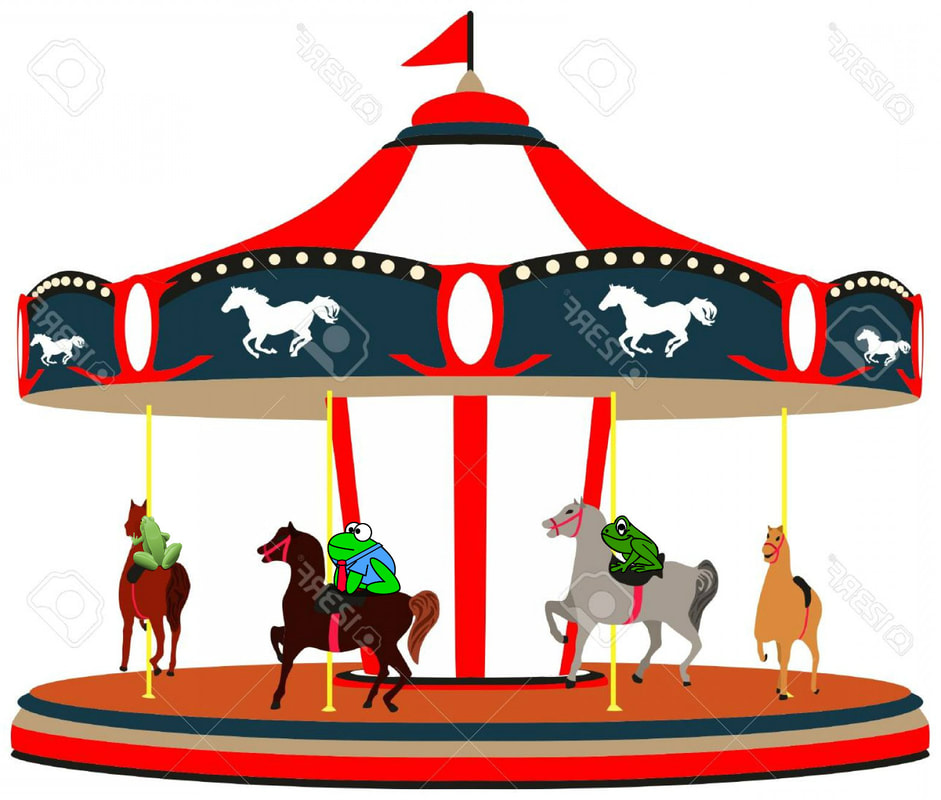Along with the roller coaster, merry-go-rounds are one of the oldest amusement rides. Everyone enjoys picking out their favorite wooden horse to ride, but there are generally lots of other animals to choose from, as well. The animals go up and down, simulating galloping while wonderful calliope music plays. Once I selected my horse and hopped up on its back, I left reality and became the greatest cowboy or knight that ever lived. I was mesmerized by carousels and would ride it over and over again...all while my parents looked on with smiling approval. I think they were secretly pleased that my heart didn't belong to the roller coaster or whirling tea cup ride. But enough of my youthful musings.....
The earliest ancestors of the modern-day carousel date back to Byzantium. Those were simply large baskets in which the riders would sit. the baskets were tied to a pole in the center of them and this would carry the riders. "But the real inspiration for modern carousels were cavalry games and jousting of 12th century Europe and Asia. Horsemen of that time participated in games at jousting competitions in which a group of horsemen would ride in a circle and throw to each other breakable balls full of perfume which needed a great skill. This game, called “the little battle” (in Italian it's garosello and in Spanish it's carosella) changed in 17th century and from the on horsemen tried to spear small rings that were hanging from poles overhead and rip them off. Cavalry ended the practice of jousting but cavalry games remained and commoners started to participate in them. At that time appeared the first simulation of carousel for children with wooden horses."
carousels became bigger and gained more appeal in the late 18th century when they started spreading in central Europe and England. The first platform carousel was made in the 19th century and were called dobbies. They consisted of a platform with animals and chariots fixed to them. They were operated manually. "The first steam-powered carousel was invented by Thomas Bradshaw in 1861 and was a part of the Aylsham Fair. Frederick Savage began making his carousels in 1870 and invented the classical mechanism that made carousel horses go up and down like they are galloping. Soon, modern carousels crossed the Atlantic and became very popular in the United States until the beginning of the Great Depression. When the Depression passed they slowly returned but never to such glory which they once had." Today there are many variants of the carousel and there are still a few from the "golden era" that work after repairs were made. The earliest known carousel that worked in America was in Salem, Massachusetts. It worked in 1799 and was known as “wooden horse circus ride”. The greatest carousel in the world is one located at the House on the Rock in Wisconsin, USA. It has 269 hand-carved carousel animals.
Carousel horses have basically three stances: they can have all four legs on the ground and are called “standing figures”, they can have two back legs on the ground and two in the air (those are called “prancers”), and they can have all legs in the air which then are called “jumpers”. “Jumpers” also move up and down. Wooden carousel horses were rarely made from one piece of wood. The central part was often made out of wooden panels connected with a wooden block and then shaped. That made a hollow body onto which head, legs, and tail that was then attached. Today's carousel animals are made from aluminum and fiberglass. They are often modeled after the classic horses of yesteryear.
Not only are carousels fun to ride, but each one is unique. Artists carve each animal, bench or car passenger ride. Ornately detailed elements decorate the poles and canopy of every carousel. What’s more, there was no limit to their imaginations! Ferocious tigers and docile lambs carry riders around. All the while the music plays its lilting tune. Undeniably, no two carousels are alike.
If you'd like to join me in celebrating Merry-Go-Round, why not take yourself for a spin on one? Or introduce a new generation to all the wonders that are a carousel.
That does it for today. Please come back tomorrow for a look at trees and why they can make us happy. Until we meet again, I wish you
PEACE.
http://www.historyofcarousels.com/

 RSS Feed
RSS Feed